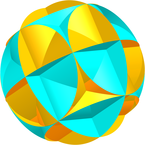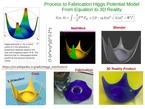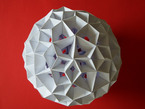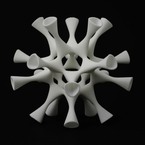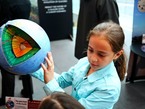42
hands-on
Licence
Credits
- Author:
- rendering algorithm:
- implementation in m3d:
Website
A sculpture visualising the relation between visible matter and the “dark forces” in modern physics.
_________________________________________________________________________
The title is a reference to Doulas Adams’ novel the hitchhikers guide to the galaxy. 42 is there the answer to the ultimate question of life, the universe and everything – a theory of everything so to speak. Like the protagonists in Adams’ novel, we can’t do anything with the answers of string theory, as we could not ask a single question, to check this theory. The only argument for the correctness is elegance. So string theory might be a possible math model of reality, but barely a scientific theory.
My sculpture 42 was inspired by a lecture of string theorist Thomas Klose about multi trousers in nine curved dimensions for spherical cows and Richard Feynman, who wrote several critical articles about string theory back in the 80’s. The doubts are still the same!
These are:
- is elegant (whatever that means in artistic or scientific purposes)
- reflects some of the mathemathical relations predicted in the standard model of physics
- no further verifiable evidence in subject
Indeed this is it. Predictions string theory makes, are all hypothetic. Maybe they stimulate fantasy of authors and screenwriters, especially possible statements about the variability of time and space. But the number of facts in this theory is exactly zero!
So my sculpture 42 can be considered equivalent to string theory as a draft for a “theory of everything”. No joke - just irony
Finally a quote of Richard Feynman, I mentioned above. I think, it is no coincidence, that he used to create the new term of cargo-cult-science, which he described as follows:
“In the South Seas there is a cargo cult of people. During the war they saw airplanes land with lots of good materials, and they want the same thing to happen now. So they’ve arranged to imitate things like runways, to put fires along the sides of the runways, to make a wooden hut for a man to sit in, with two wooden pieces on his head like headphones and bars of bamboo sticking out like antennas — he’s the controller — and they wait for the airplanes to land. They’re doing everything right. The form is perfect. It looks exactly the way it looked before. But it doesn’t work. No airplanes land. So I call these things cargo cult science, because they follow all the apparent precepts and forms of scientific investigation, but they’re missing something essential, because the planes don’t land.” Richard Feynman June 1974
The string theory – a confusing term as there are several variations in discussion, is the attempt to extend our standard model of particle physics, in order to unify all four fundamental forces – electromagnetism, gravitation, strong and weak nuclear power – in one universal theory.
For this purpose string theory postulates the zero dimensional basic particles of the standard model as one dimensional, vibrating strings. And as the four dimensional space-time is not enough to achieve this goal, string theorists add some more dimensions in which the strings can also vibrate.
But when we look at our standard model (I am talking about the Lambda-CDM-model as well as the particle model) – and this is still the basis also of string theory – there are still several problems remaining, the string theory does not even promise to solve.
One of these problems is the existence of dark matter and dark energy. The term “dark” indicates, that there is no way to observe these phenomenons directly. They only show up by their effects, that differ from the predictions the unchanged standard model makes. Regarding the huge amount of both – together they are 95.1% of the universe, to fit the theory – we seriously need to ask, whether these dark forces are real parts of our universe or arbitrary maths models, just to fill the holes in our knowledge. Does it really make sense to build up a theory of everything – like the string theory – upon 4.9% of the universe, that is known?
It should also be mentioned that we can establish a property for both dark matter and dark energy: Within our solar system, these ‘energies’ have no effect, or at least this effect is below the detection limit. Surprising to me when the quantities are that big.
At this point not a single word has been said about the mechanism, that translates the statistical, randomly “wavy” laws of particle physics, into our macroscopic and deterministic world. We must admit, that there is not even a vague idea, how this takes place.
All this suggests that our current physical paradigm may be good for creating technical mechanisms in an engineering way, but it does not help us to gain a comprehensive knowledge of our world. In my humble opinion, there is no deeper truth in that kind of physics. It is more or less an end in itself for human thirst for knowledge. In times when we have brought our one and only Earth to the edge of habitability, the question must be allowed as to whether this is the right approach to shaping the future.
Asking an unpleasant question in a most aesthetic way was the motivation behind “42”. I hope it helps us to bear such unbearable questions.
Mathematical Background
The model bases on a 3-dimensional version of so called limit sets of Kleinian Groups. This type of fractals have their origin in the work of Felix Klein, Robert Fricke and Henri Poincaré around the turn of the 19th and 20th century. They are packings of touching spheres. As in theory the spheres are touching, but not intersecting, these fractals are not connected in three dimensions (they are connected in single, 0-dimensional points in 3d space). In order to create a connected model, the hulls of the spheres have a certain thickness, so the spheres in the model are intersecting and merging at small radii. The algorithmic implementation was introduced late in 2016 by Jos Leys and knighty. As ther is no way to prjoect two dimensional, complex numbers seamlessly into three dimensional vector spaces, this model contains cracks and slices (this was clear since Jos Leys published the approach, and he mentioned this) I hope I managed to avoid them here.










